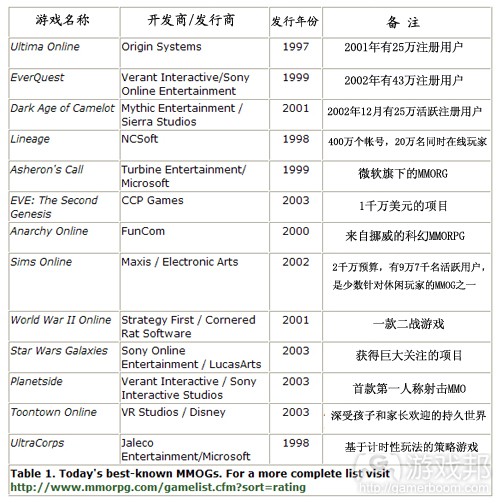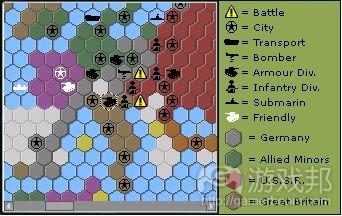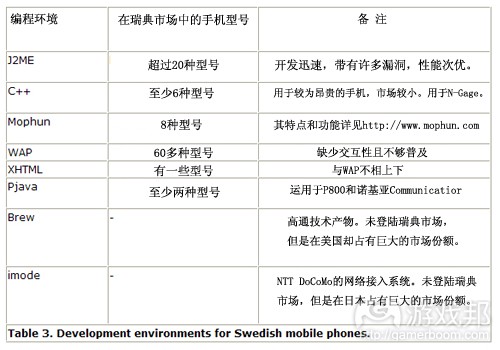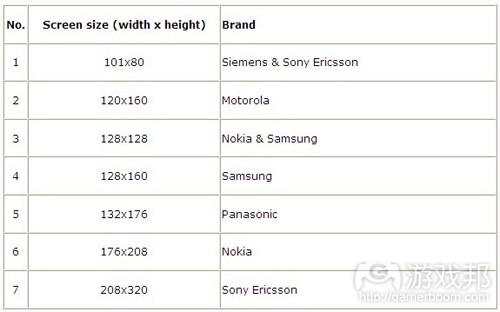从瑞典市场看开发手机MMOG的机遇和挑战
作者:Tommy Palm
不论是从操作系统还是API来看,如今的手机已经成为了一种越来越强大的计算设备。尽管市场上还存在许多纯粹用于打电话的手机,但是在不久的将来,我们将迎来人人手持“网络游戏掌机”的新时代。
手机变得越来越像网络计算机,并且成为了更加有趣的多人游戏平台。然而,当我参与了三款MMOG游戏(包括最近发行于手机设备上的《World in War》)的开发时,我更加坚信如今的手机应用开发尚处于初步阶段。手机游戏开发缺少来自成熟游戏平台所提供的足够资源。我将基于自己的经验,阐述制作一款优秀的手机MMOG(mobile MMOG,我将在文中简称为“3MOG)的基本要求。
MMOG市场
根据MMO Worlds (www.mmoworlds.com)资料显示,今天的市场上已经有将近60款MMOG(不包括针对《无尽的任务》等各种游戏的扩展包),并且还有许多正在开发的游戏。在表格1中我将列出20款当年最受欢迎的MMOG(游戏邦注:本文最初发表于2003年,以下内容及数据均以当时为准)。
MMOG连续多年成为游戏产业的热词,主要有5大原因:
寿命长。大多数PC游戏的寿命只有短短的几个月,但是MMOG却可以持续好几年,主要是因为它们能够与玩家建立起密切的联系,并且能够在玩家的游戏过程中不断发展与进化。
忠实的玩家。如果玩家通过最初程序进入游戏,并学习了游戏的基本规则(虽然可能很沉闷),他们便会忠实于游戏以及游戏社区。
巨大(潜在)利润。MMOG游戏盈利很少依赖中间商(如零售商),所以开发者可以将更多钱再投资于游戏或公司的其它业务上。而这种循环订阅能够帮助开发者通过各种方法去维持玩家对于游戏的忠实度。
更易出现技术问题。MMOG要求时刻集中运行玩家服务,这与单机游戏并不相同。而很多MMOG项目之所以会倒下是因为在开发者或发行商在发行游戏时遇到了一些不可预见的技术问题。
这类游戏存在的巨大潜能。游戏产业中很多人都预测MMOG具有广阔的发展前景,我也这么认为。虽然今天的MMOG主要针对于硬核游戏玩家,但是因为游戏具有内在的社交元素,它们也能够吸引更多休闲游戏玩家。
虽然迄今为止市场上的3MOG游戏还不多,但是这种情况在今后几年里将会发生改变。现在市场上关于3MOG游戏的最典型例子便是德国开发商Cipsoft旗下的《TibiaME》。可以说,《TibiaME》是我们众所归望的手机MMOG游戏,它类似于著名的PC MMOG游戏《Ultima Online》和《Lineage》。
我们公司在2000年开发了第一款3MOG游戏,《Football Manager》。现在,这款游戏已经拥有了每个月上千名的付费用户,并且是瑞典最大规模的在线游戏之一。我们通过在付费电视频道Canal+推广这款游戏,但是当时它仅在瑞典和挪威市场运营。
通过手机,玩家能够与团队的其他成员随时进行交流。
挑战
开发者在创造一款3MOG游戏将会面临许多有趣的挑战(因为我是来自于瑞典的一名开发者,所以我所描述的内容主要也是围绕这个领域展开)。
延迟时间
延迟时间是开发一款多人游戏必须面临的重要问题。如今大多数手机都是基于GPRS网络,而这种网络的延迟性非常高(对于游戏来说非常不利)。如果说PC游戏的延迟时间是以毫秒计算,那么手机游戏却必须用秒来计算。想象你在玩《Battlefield 1942》,而如果每一步反应需要等待4秒钟,你会有何感受?
在手机上获取正确的数据包需要比PC花费更多时间,而发送数据的速度相对来看就没那么糟了。手机的速度是9.6Kbs到172Kbs,而PC调制解调器速度是56Kbs。因此,只要我们能够隐藏手机游戏上的延迟时间,这还是一个值得加以利用的网络。表格2列举出了瑞典网络中的一些可以利用的价值。
隐藏延迟时间
如何隐藏手机上的延迟时间问题?最简单的方法便是使用回合制游戏设计。这种游戏并不适合互联网,因为在每个玩家与敌人的对抗的回合中都不会花费太长时间,因此,回合制游戏算是一种非常成功的“热座模式”(游戏邦注:一种电脑游戏与电视游戏中的多人游戏模式,指多个玩家使用同一台终端,轮流控制自己在游戏中扮演或指挥的人物或国家行动)版本。回合制游戏的另外一个缺点便是,参与游戏的玩家越多,每个玩家的游戏时间就越少。
计时性游戏玩法(tick based gaming)能够很好地解决这个问题。在采用计时性游戏玩法的回合制游戏中,玩家可以预先规划自己的行动,然后游戏便会同时执行这些操作。这种模式在大型多人网络游戏中已经很普遍了,但是很多高预算游戏项目却很少使用这一方法(《UltraCorps》是个例外)。计时性游戏玩法很适合策略游戏,以及一些策略子类型游戏,如“经营类”游戏,战争游戏,资源管理游戏等。
当然了,这并不是我们在玩MMOG所使用的方法。然而,根据这些技术性限制而重新进行设计,很多即时多人游戏设计也同样能够处理延迟时间的问题。虽然第一人称多人射击游戏无法通过重新设计来处理这种延迟问题(因为这类游戏中的操作很直接,其游戏玩法要求玩家快速执行操作),但那些本身就含延迟特点的游戏却可以想法隐藏这个问题。例如,想象你在游戏中控制着一艘西班牙大型帆船,当你降下帆布或者调转船头都需要花费一定的时间,但你可以在执行这些动作期间隐藏延迟时间。
关于隐藏延迟时间的另外一个典例是《模拟人生》,玩家在游戏中间接控制游戏角色。游戏角色可以无需玩家指示自己在游戏中行动,因为命令生效时玩家还有其它任务,所以游戏角色自然也可以不用立即做出反应。
设备混乱状态
在PC时代刚刚开始的时候,市场上也存在许多不同的PC制造商,就像今天的移动产业中聚集了许多手机制造商一样。但是随着时间的流逝,PC市场越来越趋于同质化。虽然还未达到掌机市场的程度(即玩家能够明确地猜到游戏必须存在于哪些硬件中),但是在PC领域,你必须根据某些特定标准,如屏幕大小,内存,输入设备如鼠标,键盘以及操纵杆等选择设备。
如今手机市场所提供的硬件设备统一性还远远不如PC市场。例如,在瑞典有来自10家制造商所创造的80种手机模式。不仅屏幕多种多样,手机的按钮以及按钮的分列也各不相同。除非统一了基本硬件性能标准,要不开发手机游戏仍是一个棘手问题。
从以上图表可以看出,WAP在瑞典拥有最多市场份额,即超过60种手机型号,但是WAP只支持少量的互动游戏技术。在850万的瑞典人口中,有200万人在使用基于WAP的手机,但是却只有10万人使用过这种硬件性能。从互动应用的编程环境来看,J2ME占有最大的手机市场份额,但是与C++相比它也存在一定缺陷。例如,选择J2ME就意味着你必须依赖Java Virtual Machine,而如此你便难以控制函数调用和网络连接了。如果出现网络断开的情形你就必须面对每次网络呼叫长达10秒的时间延迟,而这种延迟并不利于开发3MOG。除此之外,使用J2ME你便需要反复修改因JVM而非自己的代码产生的漏洞。
屏幕大小,输入设备和其它限制
屏幕大小。关于手机屏幕大小有两种看法:小屏幕以及没有标准限制。
制作一个能同时适合不同屏幕大小的界面真的很难。针对800*600像素进行优化的HUD视觉效果明显不如1600*1200像素的HUD,而如果你希望它能够同时适用于不同分辨率,那就必须投入更多开发时间。
唯一实际的解决方法便是使用贴图方法,而整个文本框将会被不同线条区分开来。但是全屏2D位图就不能这么做。
在游戏开发中,小屏幕也不一定是缺点。玩家自然不会期待《半条命2》在手机上也能拥有PC上的高清图像,而玩家这种较低的期待正中开发者下怀。所以当他们开发手机游戏时,显示器尺寸便不会对游戏产生太大的影响。
应用程序大小限度。应用程序大小会根据不同模式而有所不同。标准的大小是64KB,而这一数值对于MMOG来说真的很小。一些较为强大的手机拥有额外储存卡,允许运行较大规格的应用程序。不用说,后者的设置更适合游戏开发。
颜色深度。不同手机的颜色深度也不同,但是幸运的是可供选择的颜色深度并不多。虽然也有例外,但是大多数带有应用程序功能的手机都支持12-bit(4096种颜色)或者16-bit(65535种颜色)的颜色深度。这两种颜色深度都足够了,所以开发者无需投入更多精力去找其中的差别了。
运营商问题
手机的网络连接不如PC那般轻松。没有一款MMOG能够脱离网络而存在,手机的网络连接问题取决于运营商的表现。运营商通过软件传输网络程序包,并且在很多情况下,这些信息的传输总是时断时续,并不顺畅。解决这个问题需要一定时间。所以,在选择运营商之前你必须对其进行全面的测试(而如果你希望同时在不同国家发行游戏,那么这便是一笔不小的开支)。在自己的国家发行游戏是最简单的,因为你能够方便地与本地运营商取得联系并让他们帮你解决网络连接问题。而且,运营商总是有自己的时间安排和计划,他们总是很难顾及到一位小游戏开发者的截止日期或者局限性等。所以,开发者应该尽量确保时间安排的灵活性,为自己预留一些应变空间。
用户行为
手机用户的使用行为与PC和掌机的用户行为大不相同,开发者在设计3MOG时需要注意这个问题。研究表明,用户体验手机游戏每次只会持续几分钟。从某些方面看来,这种情况更适合3MOG,因为比起要求玩家在每次游戏都重新开始,持久的世界更适合使用短时间的游戏循环设置。
手机游戏更需要紧密围绕玩家的现实情境。如果玩家在游戏的角色死去后不能再次复活——例如玩家下车或接个电话而暂时不管游戏而导致游戏结束,那么玩家便会对此感到不满而退出游戏,因此影响了游戏的收益。创造一款能够迎合手机玩家频繁变化的情境便是3MOG设计师需要面对的一大挑战。让玩家能够间接控制游戏角色算是一种解决方法。如果能让游戏角色自己做决策,那么即使玩家因为某些事而暂时离开游戏也不会对游戏的发展产生多大影响。
发行商的角色
作为3MOG游戏开发者,你其实正处在游戏产业的前沿。现在,越来越多发行商都不愿意承担风险,反而在等待着别人能够先一步采取行动,这其实也意味着那些敢为人先的发行公司将获得许多机遇。
而我们公司本身也并未依赖游戏发行商,而是自己资助游戏开发,并且与传媒公司合作销售游戏。传媒公司本身就拥有许多用户,并且总是在寻找新的盈利渠道。如此看来MMOG和传媒公司非常合拍:因为付费游戏正需要不断寻找大量玩家。
如果你想制作一款3MOG,那么获取资金的最佳方法便是自己掏腰包。不要对此感到绝望,因为根据我们的经验,制作这种游戏并不需要你投入5千万美元的巨资。我们发现玩家总是希望自己能够参与游戏的创造过程,并且愿意尝试那些较为“简陋”的游戏设置,因为他们能够在游戏过程中帮助开发者更好地完善游戏。
机遇
说实话,如果你正在考虑创造一款3MOG,那么这篇文章并不能给予你太多的鼓励。但是也不要轻易放弃,因为要知道,了解障碍与掌握机遇同样重要。
常有人问道“手机游戏将会成为真正的大势?”有些人会回答“我并不这么认为,因为我并不愿意坐在沙发上盯着一个小小的手机显示屏玩游戏。”的确,我也不认为手机游戏能够代替掌机游戏。相反地,我认为手机游戏可以作为掌机游戏的相应补充内容,以下是几点原因:
随时随地玩游戏。手机做为游戏平台的一大优势是玩家可以随时携带这一设备。MMOG作为一种社交游戏总是围绕着玩家间的交流与互动,而手机所带有的频繁、短期访问游戏世界的功能更是能够强化这类型游戏的社交性。
我们已经见识过PC MMOG在处理玩家互动方面的特点——玩家的交流与协作程度在不同类型游戏上也会有所差别。例如,在《EVE: The Second Genesis》中,玩家也可以不依赖任何社交互动而单独玩游戏。在这种情况下,游戏社区更像是一种暂时性的维护组织,即玩家可以在此询问其他玩家相关的游戏问题。虽然这种互动性较为有限,但是却也能够满足大多数玩家,并缓解他们在单人游戏中所遭遇的挫折。如果玩家不能顺利通关,他便能够询问其他遇到相同问题的玩家。即使其他玩家帮不上忙,玩家也会因为将挫折与别人分享而倍感轻松。如此便能够更好地凸显MMOG游戏中的社交互动性,而这也是3MOG游戏设计师可以参考的内容。
对休闲玩家具有较大的吸引力。MMOG的社交因素能够吸引休闲玩家的注意。休闲玩家希望游戏尽可能的简单易学,并且不希望长时间地重复相同的游戏行为。成功的3MOG游戏应该能够同时支持长时间与短时间的游戏过程。
持久与普遍。大多数MMOG游戏都设立了持久的游戏世界,甚至超越于玩家的游戏过程。这一点对于拥有有限储存空间和计算能力的手机尤为重要,因为开发者可以使用服务器去实现这些内容。持久世界可以建立在服务器上,即使是仅有64KB的客户端也能支撑大规模的游戏世界。
3MOG还具有掌机游戏所没有的一大优点,即能够在任何时候向玩家传达游戏事件和信息。虽然这种功能很容易被滥用,并惹恼玩家,但是如果设计合理的话,这些功能便能够强化玩家的游戏体验并创造出新颖的游戏情境。想象在一款野战游戏中,玩家必须轮流守护营地。而如果敌人发动了袭击,玩家便可以通过手机接收到相关信息快速回到游戏中做出防卫。但在这种情境下,玩家也必须先表明自己在哪些时间下能够接收游戏信息,以免游戏影响自己的现实生活。
跨平台能力。手机市场的分散性问题严重,没有必要在客户端的编码工作上投入过多精力。
为了获得更大的市场,你必须为游戏创造出不同的版本,所以创造一个小型客户端能够帮助你更轻松地将游戏移植到其他新平台。
完全开放的市场。手机游戏仍然处在发展阶段,这个市场上也出现了一些非常优秀的游戏,这里还有非常广阔的发展空间。
幸运的是,网页和手机应用之间的相似点并不多。如果你正使用Java编程,那就有可能针对不同平台重用一些资源。
尽管作为一种游戏平台,手机拥有许多让人兴奋的特殊功能,但是其声音和视觉体验效果却不甚完美,但通过添加一个网络(或者是PC)界面,你的游戏便能够带给玩家更棒的体验。而跨平台游戏能够让玩家基于不同媒介更好地感受并理解真正的游戏世界。
游戏邦注:原文发表于2003年9月13日,所涉事件及数据以当时为准。(本文为游戏邦/gamerboom.com编译,拒绝任何不保留版权的转载,如需转载请联系:游戏邦)
The Birth Of The Mobile MMOG
by Tommy Palm
Mobile phones are becoming increasingly powerful computers, complete with operating systems and standard APIs. Although most phones on the market are still useless for anything more than phone calls, we are slowly moving into an era where many people will walk around with a (potential) networked game console in their hand.
As mobile phones increasingly resemble networked computers, they become more interesting as platforms for multiplayer games. Yet, as someone who helped develop three MMOGs (including World in War, which was recently released for mobile devices), I can vouch for the fact that application development for mobile phones is still in its infancy. Mobile game development lacks many of the resources that more mature gaming platforms offer. Based on my experience, I will describe what I believe are the essential requirements for making a successful MMOG for mobile devices – a genre that I’ll refer to as “3MOG” in this article.
The MMOG Market Today
According to MMO Worlds (www.mmoworlds.com), there are almost 60 MMOGs on the market today (not counting the various expansion packs for games like EverQuest), and many times that number of MMOGs under development. The 20 most well known MMOGs on the market are listed in Table 1.
Ultima Online
250,000 subscribers as of 2001
EverQuest
430,000 subscribers as of 2002
Dark Age of Camelot
250,000 active subscribers as of December 2002
Lineage
4,000,000 accounts, 200,000 simultaneous players
Asheron’s Call
Microsoft’s MMORG.
EVE: The Second Genesis
A $10 million project.
Anarchy Online
A futuristic MMORPG from Norway.
Sims Online
A $20 million budget, 97,000 active players. One of the few MMOG trying to target casual gamers.
World War II Online
A WW2 game.
Star Wars Galaxies
Huge project with lot of attention.
Planetside
The first MMO first-person shooter.
Toontown Online
A persistent world for children and their parents.
UltraCorps
Tick-based strategy game.
The MMOG genre has been a powerful buzzword in the game industry for years now. I see five interconnected reasons for this:
Long lifespan. Most PC games have a life span of just a few months, whereas MMOGs can last for years partly because of their tight relationship with players and their ability to evolve the game world around the player.
Player loyalty. If a player passes the initial rituals for entering and learning the basic rules for the game (which are admittedly often tedious), they tend to become loyal to that game and its community.
Large (potential) margins. MMOGs often adopt a business model whereby the income is less dependent on a middleman (i.e., a retailer), so a larger part of the money can be reinvested into to the game and/or company. A side effect of this that the recurring subscriptions increase the developer’s incentive to keep players loyal through various means.
Greater chance for total disaster. MMOGs require centralized player services that need to be running all the time. That’s very different than a stand-alone game. Many MMOGs have had encountered disasters at launch because the developer and/or publisher encountered unforeseen technical problems.
The huge potential for the genre. There are a lot of industry projections that predict that MMOGs will be huge in the future , and I hold this opinion too. While today’s MMOGs usually target hardcore gamers, they have the potential to attract more casual gamers too, based on the social aspects inherent to the genre.
To date, not many 3MOGs have been released, but that will change over the next few years. A good example of a 3MOG currently on the market is TibiaME from German developer Cipsoft (see Figure 1). TibiaME is what you might expect a MMOG to look like on a mobile phone; it resembles popular PC-based MMOGs like Ultima Online and Lineage.
Figure 1 TibiaME, the only MMOG accessible from a hot air balloon.
My company’s first major 3MOG is called Football Manager, which we began developing in 2000. Now on the market, the game has thousands of monthly paying customers and is one of the largest Swedish online games. The premium television channel Canal+ markets it, but it’s only available in Sweden and Norway at the moment.
Figure 2. Football Manager – the PC game.
The game is accessible via mobile phone too, allowing players to interact with their team at any given moment (Figure 3).
Figure 3. Football Manager – the mobile phone version.
The Challenge
Creating a 3MOG offers many interesting development challenges, some of which I will describe. Note that my experience is based largely upon my experience as a developer in Sweden; some of the factors I describe may vary from region to region.
Latency
Latency is always an important issue when developing multiplayer games. Most mobile phones run on GPRS networks, which have very high latencies (bad for games). Whereas latency in network calls for PC games is measured in hundreds of milliseconds, for mobile phones latency is typically measured in seconds. Imagine trying to play a game of Battlefield 1942 and always seeing what happened four seconds ago.
While getting the correct packets on a mobile phone can take more time than on a PC, the speed of sending data is comparatively not so bad. It typically ranges from 9.6Kbs to (in theory) 172Kbs, compared to a PC’s dial-up modem speed of 56Kbs. Therefore, as long as we can hide the latency in a mobile game’s design, there is actually a pretty good network to work with. Table 2 shows some values that we have seen in our Swedish networks (these are anecdotal measurements).
Design to Hide
How can these long latencies on mobile networks be hidden from players? One simple answer is to use a turn-based game design. This kind of game works poorly over the Internet, since it’s hard to hassle an opponent for taking too long during his turn. Thus, turn-based games have been much more successful in “hot seat” versions. Another drawback to turn-based games is that the more players there are, the less playtime each person gets.
Tick-based gaming is a solution to this problem. In tick-based gameplay, you take a turn-based game and allow all players to plan their moves ahead of time, and then the game executes all the moves simultaneously. This model is fairly common in massively multiplayer web games , but it hasn’t been adopted by many high-budget projects (a notable exception is UltraCorps). The tick-based model works best for strategy games, in strategy sub-genres like “manager” games, war games, resource management games, and so on.
Of course, this is not the way we are used to playing MMOGs. However, the design of many real-time multiplayer games could be accommodated to handle much higher latencies if the game was redesigned with those technology limitations in mind. While a multiplayer first-person shooter probably couldn’t be redesigned to handle high latencies (since actions are so direct and gameplay requires fast action), games that have natural delays in them might be able to hide latency. For instance, imagine a game in which you command a large Spanish galleon. When you give the order to lower the sails or make a full turn, it takes the ship some time. Latencies could be hidden between the time the order was issued and its execution completed.
Figure 4. The J2ME client of World in War, a tick-based 3MOG.
Another good example of hiding latency is seen in The Sims, where the user influences indirect control over the game characters. Since the characters move around on their own, even without the player’s direction, the player has something to watch while the command takes effect, and there are plausible reasons for the character to not react instantaneously.
Figure 5. Hiding high latencies on mobile networks is possible through careful game design, such as the time between issuing an order to a boat and when the order has been executed.
Device Anarchy
In the beginning of the PC era there were many different PC manufacturers — just like the mobile phone industry today. Over time, the PC market has become rather homogenous. Surely not to the extent of the console market, where you know precisely what hardware the game will be played on, but there are certain standards that you can rely on like screen size, amount of memory, and input devices like mouse, keyboard and perhaps joystick.
The mobile phone market doesn’t offer as much hardware certainty as today’s PCs. For instance, in Sweden there are about 80 phone models from about 10 manufactures. The screen sizes vary wildly, as do the number of buttons and their locations on the phones. It may go without saying that until there are standards for the most basic hardware capabilities, developing mobile games will be difficult.
As you can see in Table 3, WAP has the largest market share in Sweden with over 60 phone models available, but WAP supports fewer technologies suitable for interactive games. In Sweden, two million people out of a total population of 8.5 million have access to a WAP-based phone, but only 100,000 have ever used these capabilities . Among the programming environments for interactive applications, J2ME covers the largest mobile phone model segment, but it has several drawbacks when compared to C++. For instance, with J2ME you must rely on the Java Virtual Machine and you have less control over function calls — and that can mean less control over the network connection. Network disconnections can add latencies of up to 10 seconds per network call, which can be a big drawback for a 3MOG. In addition, with J2ME you often end up trying to fix bugs caused by the Java Virtual Machine, not your code.
J2ME
Fast development, lots of bugs, sub-optimal performance.
C++
Rather expensive phones, small market segment. Works on N-Gage.
Mophun
See http://www.mophun.com for specs and features.
WAP
Limited in interaction and popularity.
XHTML
Comparable to WAP.
Pjava
Works on the P800 and Nokia Communicator.
Brew
Qualcomm’s technology. Not available on any phone marketed in Sweden, but has significant market share in the United States.
imode
NTT DoCoMo’s Internet access system. Not available on any phone marketed in Sweden, but has significant market share in Japan.
Screen Size, Input and Other Limitations
Screen Size. There are two major hassles when it comes to screen size on a mobile phone: it is small and there is no standard size (not even a standard proportion!).
Building an interface that supports different screen sizes is incredibly hard. A heads-up display that has been optimized for 800×600 pixels will not look as good on 1600×1200 (and excludes game play in 640×480) and will take valuable development time if your ambition is to make it work at all resolutions.
Figure 6. Various screen sizes on different phones.
The only real workaround to this problem is to use tile-based graphics and accept that text will break for a new line whenever it feels like it. Full-screen 2D bitmaps are almost out of the question.
Note that small screen size is not always a bad thing when it comes to game development. Players do not (yet) expect the quality of graphics on mobile phone to match that of Half-Life 2, and these lower player expectations can work in a developer’s favor. When it comes right down to it, the display size has little impact on the success of the title.
Application size limit. Application size is limited on many models. A common size limit is 64KB, which is tiny for MMOGs. Some more capable phones have an extra memory card, allowing applications to be several megabytes in size. Needless to say, it is easier to develop games for the latter.
Color depth. Color depth also varies substantially between phones, but luckily there are not an infinite amount of color depths from which to choose. With a few exceptions, most phones with application development possibilities support 12-bit (4,096 colors) or 16-bit (65,535 colors) color depth. Both are quite sufficient, so game developers do not have to focus too much energy on the differences between the two.
Operator Issues
Internet connectivity for mobile phones isn’t as easy as it is for PCs. There can be no MMOG without networking, and when it comes to Internet connectivity for phones, everything relies on the capabilities of the operator. On mobile phones, network packages are transmitted via the operator’s software, and in many cases those messages are like frogs crossing a highway: sometimes they make it, sometimes they don’t. This problem is bound to work itself out with time. Currently, however, all operators that you plan to support need to be thoroughly tested (which isn’t cheap if you want to launch your game in several countries simultaneously). My suggestion is to launch your game in you own country where it’s easiest to contact mobile operators to troubleshoot any connection problems. A word to the wise: operators have their own schedules and product plans, and many aren’t concerned with the deadlines and constraints of a small game developer. Make sure you build some flexibility into your schedule and save yourself some stress.
User Behavior
Phone usage behavior varies greatly from PC and console playing habits. This must be taken in consideration when designing a 3MOG. Studies show that the average gaming session on a phone lasts just a few minutes. In some respects, this fact bolsters the case for 3MOGs since a persistent world can make better use of short playing cycles than a game that requires a player to start a new session each time the game is played.
Mobile games must behave politely and accept that the player’s situation must always come first. A game in which the player’s character dies and can’t be resurrected — just because the player got off the bus or answered a phone call — will aggravate users and result in fewer players and lower revenues. Devising multiplayer functionality to accommodate frequently distracted players is one of the great challenges facing 3MOG designers. Indirect control of your character might be one way to overcome this. If the game character can make its own decisions, the sudden absence of the player is not as obvious.
The Publisher’s Role
As a 3MOG developer, you’re working in one of the game industry’s frontiers. As such, you’ll be on your own in many respects – perhaps even without a publisher. Publishers are very risk averse these days, and they all seem to be waiting for someone else to make a move in this genre. Perhaps that means that there’s a window opportunity for a brave publishing company.
In our case, we financed our titles without publishers and brought our games to market by making deals with media companies instead. Media companies often have large audiences already and are always looking for new ways to make money from them. MMOGs and media companies seem to be a good match: premium games looking for a large audience.
If you have an idea for a 3MOG, the most likely way it will get financed is from your own wallet. Don’t despair, though — one of our biggest lessons has been that it doesn’t take a bankroll of $50 million to get a game started. We’ve found that players like feeling that they are part of the game creation process, and will accept fairly rudimentary gameplay if they have a hand in helping the developers mold it into something grander over time.
The Opportunity
Admittedly, if you are thinking about creating a 3MOG, this article might not offer you all the encouragement you were looking for. Don’t give up just yet, however. Knowing the obstacles is at least as important as knowing the opportunities. Now that we’ve touched upon many of the hurdles you could face, let’s look at the opportunities that await.
A commonly asked (and very important) question is, “Will mobile gaming become really big?” In response, I’ve heard people say things like, “I doubt it — I’ll never sit on my sofa and play a game on a tiny phone display”. The truth is, neither would I, and I don’t believe mobile gaming can compete with console gaming in those same terms. However, I do believe that it’s a complement to console games, for several reasons:
Always with you. One of the most interesting aspects of the phone as a game platform is that you are never far from your phone. MMOGs are very social games that revolve around player communication and interaction, and the social aspects of MMOGs can be enhanced for phones by supporting more regular, but shorter, visits to the game world.
Already we see how different PC MMOGs handle player interaction — the level of player communication and cooperation varies substantially across the genre. For instance, in EVE: The Second Genesis, you can play the game like it was a single-player game, without virtually any social interaction. In that case, the community acts more like an instantaneous support organization where you can ask other players questions about the game. This limited interaction can nevertheless be very satisfying for players, and alleviates some of the frustrations found in single-player games. If a player cannot get past a certain situation, he can ask other players if they have experienced the same problem. Even if other players can’t help, it’s often a relief to just talk about the problem with someone. Therefore, the level of social interaction in MMOGs has been successfully tinkered with, and that may be instructional to someone wondering how to handle similar situations in 3MOGs.
Growing appeal for casual gamers. The social aspects of MMOGs can be very appealing for the casual gamer. Casual gamers tend to demand games that are easy to learn and don’t demand long game sessions with lots of repetitive game play (like mining, monster melees, and so on). The most successful 3MOGs will be the ones that support long and short game sessions.
Persistent and pervasive. Most MMOGs use persistent worlds; game worlds that outlive the user sessions. This aspect is particular important for mobile phones that have limited storage and calculating capabilities, because much of this work can be offloaded to the server instead. In a persistent world, the game state is held on the server, making enormous game worlds possible even on a client as small as 64KB.
However, 3MOGs have another advantage that console games lack: the ability to push game events and messages to the user at any time. It is obvious that this possibility might easily be misused and annoying to players. Yet designed correctly, this feature could enhance the game experience and create innovative scenarios. For instance, image a wargame in which players must take turn guarding their base camp. In the event of an attack, all players can be summoned to defend their common base via an incoming phone message that takes them into the game action. In this type of scenario, users should naturally be able to indicate when it is OK for the game to contact them so that the game doesn’t get in the way of important things going on in the real world.
Cross-platform capabilities. Considering that the phone market is so differentiated, it doesn’t make sense to code too much of the game logic for the client itself. To reach the largest market, you will probably need to have some different versions. Creating a thin client minimizes the effort to convert a game to a new platform.
Wide-open market. Mobile gaming is still in its infancy and there are few really good projects on the market, leaving the door open to newcomers.
Fortunately, the similarities between web and phone applications are not very large. If you’re your game was written in Java, it might even be possible to reuse classes between different platforms, too.
In spite of all the exciting abilities the phone, as a gaming platform, it has not the ultimate sound and visual experience and will not have for a foreseeable future. By adding a web (or even a PC) interface, your game can become a richer experience. Cross-platform games also increase the feeling of a game that expands out of its medium, and strengthens the players’ idea of what the game world really is. (source:gamasutra)















































 闽公网安备35020302001549号
闽公网安备35020302001549号